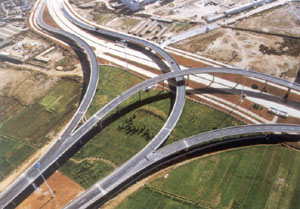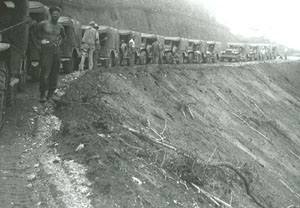 __
__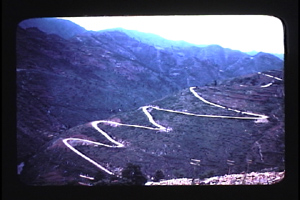 __
__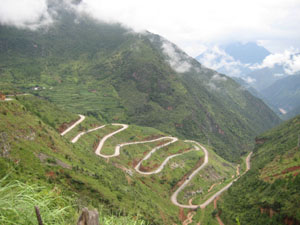
Return to China, 2008 -- Part II: West on the Burma Road
We've had our two days in Beijing, five days in Kunming -- met with the Mayor -- and now we're headed west on the "Burma Road." We're going to retrace the footsteps (or tiretracks) of Dr. Clinton C. Millett (Dr. C.C. is Gregg's father, Kim's grandfather and Devin's great-grandfather). In 1945 Dr. Millett led the convoy of the U.S. Army's 172nd General Hospital from Ledo India to Kunming China -- a seventeen-day trip. It took the convoy nine days to go from Tengchong (near the Burma Border) to Kunming. Today it has taken us nine hours to travel from Kunming to Tengchong. Dr. Millett was in a jeep; we are in a 2008 Honda Odessey with built-in GPS. Dr. Millett drove on a dirt road; we drove on a four-lane highway, through twelve tunnels, from Kunming to Baoshan and on a two-lane highway seventy more miles to Tengchong. Below is a photograph of the 1945 convoy (left); a photograph of the road taken by Dr. Millett (center); and a photograph taken by Kim in 2008 (right).
 __
__ __
__
On April 2, 1945 Dr. Millett wrote to his wife Martha: "We are going through country this morning that is true China as we have read about it. Flooded rice paddies are everywhere with Chinese plowing with wooden plows and buffalo. Women with bound feet, many full-grown women with feet not over 4 inches long. Houses are mud and straw brick with thatched roofs. The towns are being rebuilt because most towns have been demolished by bombing. All along the roads are women, children and men on the road to market. All carry baskets slung on the end of a pole across their shoulders. Two of Dr. Millett's 1945 photographs are below (left and center). Kim's 2008 photographs is on the right.
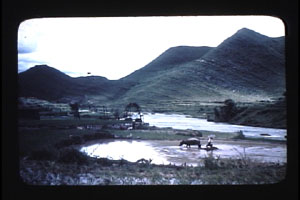 __
__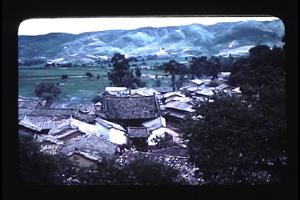 __
__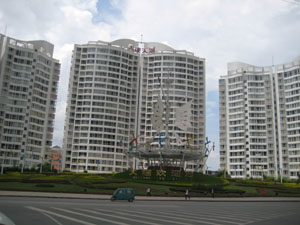
Where the four-lane highway becomes two lanes, we eat lunch at a Dai restaurant in Lujianba -- fava beans, bamboo shoots, pumpkin and chicken soup. We travel on through valleys and mountain s-curves and along the Nujian River and Lujian Plain, with Mt. Gaoligong to the immediate north, and cross the Salween River into Tenchong.
 __
__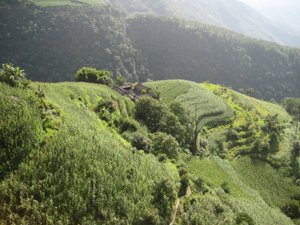 __
__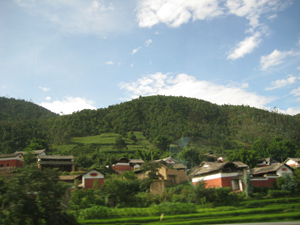
Indeed this western area of Yunnan. along the Burma Border, is home to several of China's ethnic minority groups (only 8% of China is non-Han -- there being 55 minority groups); however, in Yunnan 27% of the people are non-Han ethnic minorities (25 groups). On this trip we encounter the Bai, Dai, Naxi and a sub-group of the Naxi known as the Mosuo. The Mosuo Peoples will be the subject of our Part III Trip Report. Below is a picture taken by Dr. Millett in 1945 of the Nagas in Burma (left) and photographs taken by Jin Fei Bao of the Jingpo, Bai, Sui, Wa and Dai peoples of Yunnan.
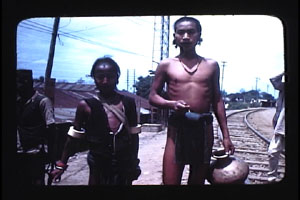 __
__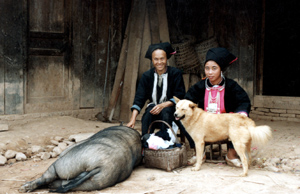 __
__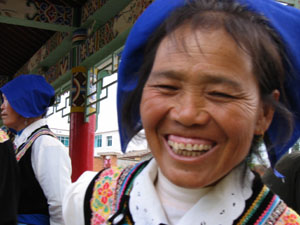
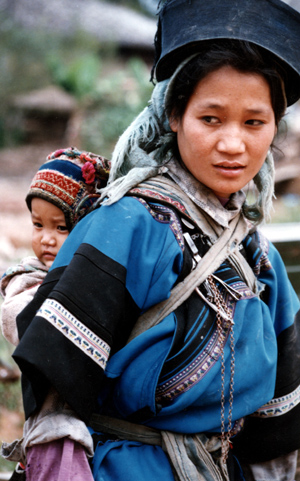 __
__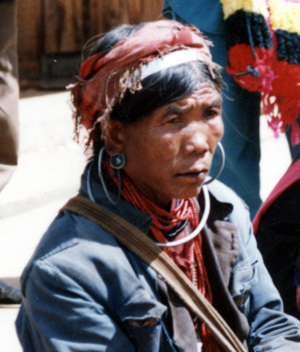 __
__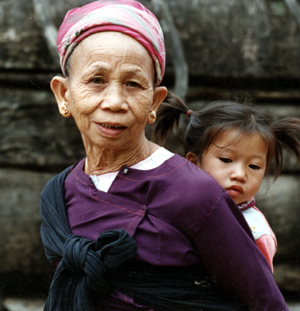
Arriving in Tengchong we drive a few more miles to Heshun Village where we go through a security check and pay to enter -- a gated community! We are met by a VIP delegation and, after tea, taken on a tour through the village including the home of Chinese philosopher (Aisiqi), a WWII museum, several gift shops, a library (the largest village library in China) and around the beautiful small lake. We check into our hotel and enjoy a fabulous dinner back at the Tea House. We are VIP's (because we are with Jin Fei Bao!) and because we are family members of a WWII China veteran. We learn that Tenchong is not only a famous WWII battle site but that it was a key city on the old south "silk road" (and was visited by Marco Polo) and that during the Ming Dynasty (1268-1644), 3,000 craftsmen created much prized objects from the local deposits of Jade. The area is also known for it's volcanoes, hot springs, aromatic coffee and the finest tea in China. Images of Heshun are below.
 __
__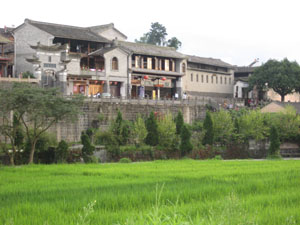 __
__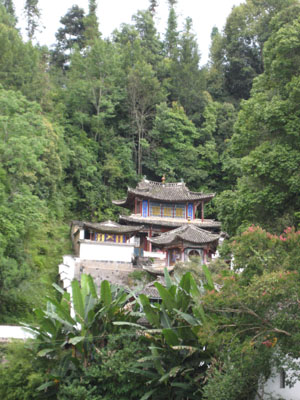
 __
__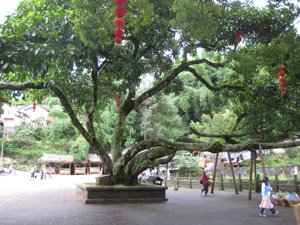 __
__
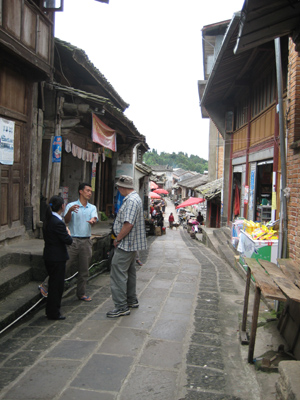 __
__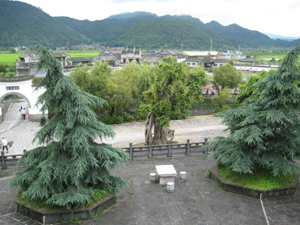 __
__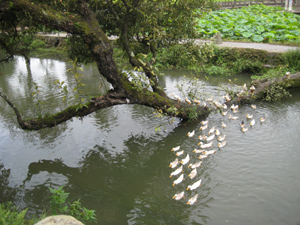
We wake up to the cool, green, rice-planted valley of Heshun and head for the Tengchong WWII Memorial Cemetery. This is a very moving experience with thousands of grave markers, steep steps that go to a hilltop monument and sculptured reliefs on a long wall depicting many scenes of the US/China bond in World War II. There is also a special monument to the nineteen American soldiers killed in the battle of Tengchong with each soldier's name engraved on a separate stone. The battles of Tengchong/Sungshan, in 1944, were one of the turning points in the war, where the Japanese advance into China from the West was stopped. Additional battles would be necessary to open the Ledo-Burma Road for Allied convoys to bring supplies to China. Meanwhile, the "Flying Tigers" were the American heroes in the air; the "Hump Pilots" were flying supplies into China from India; the construction engineers, composed mainly of African-American soldiers, were blasting and slogging their way through Burma to connect the new Ledo Road with the Burma Road; and General Stilwell, with American and Chinese forces, along with British and other allied forces, were waging a brutal struggle in the jungles of Burma. On the other side, the Japanese, with fewer soldiers and dwindling supplies, were fighting to the death of almost every soldier.
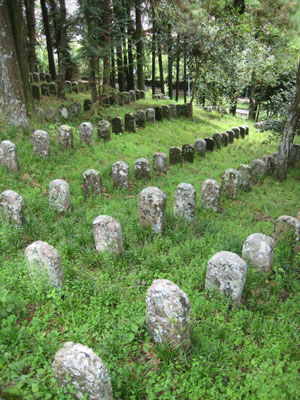 __
__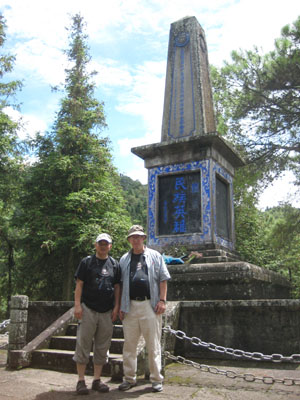 __
__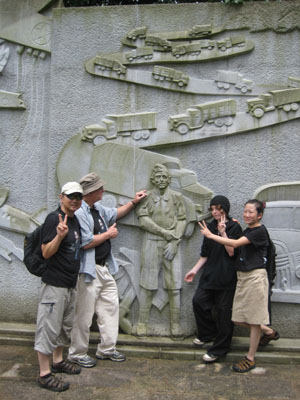
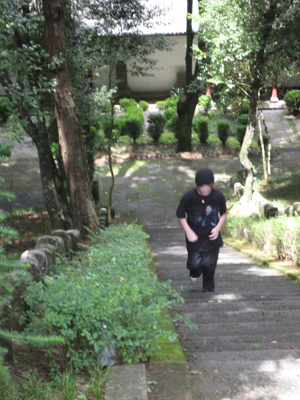 __
__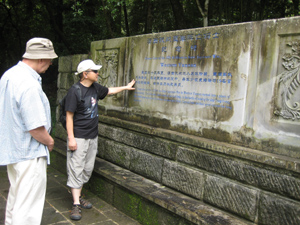 __
__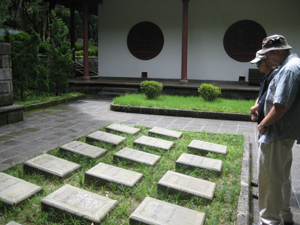
A few historical notes:
From Gerald Astor -- "The Jungle War" -- A critical battle developed around the walled city of Tengchong, site of a major Japanese strongpoint. Chinese casualties were very high. The Japanese sat on the high ground looking down the trails and mowed the Chinese down until by sheer numbers the Chinese were able to outflank the Japanese, who would retreat to the next crest ... To each Chinese division in combat was assigned an American surgical team, consisting of five doctors and about thirty technicians ... we sat outside the city for two or three months watching the Chinese artillery pound the city ... finally, the largest air strike of the campaign (by the Fourteenth Air Force -- formerly "The Flying Tigers") ... created a sizable gap in the wall which assisted the Chinese to break into the city. Fighting was fierce, but the Chinese army group commander would order the troops to advance to a certain point by the next day, or all commanders below the rank of battalion commander would be shot. Needless to say, there was soon a shortage of captains and lieutenants. It reached a point where any soldier who could read and write was commissioned ... The city finally fell.
From Donovan Webster -- "The Burma Road" -- Tengchung fell ... after a fifty-one-day siege that had started when the Chinese Fifty-sixth Division had arrived on the edges of the city only to see the Japanese Fifty-sixth Division either withdraw out of the valley or retreat inside Tegchung's ancient walled city. Tengchung had been old even when Marco Polo was said to have visited in the thirteenth century. The core town inside its walled citadel -- where jade and precious goods had been traded since medieval times -- could house twenty thousand people. The walls of Tengchung's ancient city were thirty-five to forty feet high and as much as sixty feet thick at the base and eight feet thick along their tops. For a period of time, the Chinese ... pounded Tengchung ... with mortars ... waiting for the Japanese to begin to starve ... After several weeks ... the Chinese decided to make a frontal attack ... They began unsuccessfully to scale the ancient city's ramparts with ladders ... The key to Tengchong's destruction was finally Chennault's Fourteenth Air Force bombers, which not only smashed most everything inside the city walls ... but bashed huge holes in the imposing fortress itself. With the ancient city's ramparts now broken, the Chinese -- spraying streams of gasoline ahead of them and igniting it with flamethrowers -- took the old city.
From Wen Jiang -- "A Search of Sixty Years" -- Shortly after the completion of the Salween Campaign in the fall of 1944, the Memorial Garden of Tengchung was built to commemorate the thousands of Chinese soldiers killed in the war. A special tomb stone was erected for the fallen American soldiers. Nevertheless, due to the scarcity of information available to the people in the area at that time, only one name, 1st Lt. “Xia Bo Er” in Chinese, was engraved. It was not until recently that some of us in China learned that, in addition to the famous U.S. 14th Air Force (the Flying Tigers), there was a special American Army force, named the “Y-Force”, that assisted the Chinese during the Campaign. This brave force was almost forgotten in the history of World War II. But local people said, “We remember them.” They wanted to find out the full names of the forgotten soldiers and engrave them on a new tombstone so their heroes wouldn’t be unknown to the remote land where they sacrificed their lives. In 2002, a special search was launched to discover the full names of these American soldiers. .... All together, 19 full names of fallen American military men were identified. In September, 2004, during the commemoration of the 60 year anniversary of the Salween Campaign, a new tombstone was erected to commemorate those 19 American military personnel who sacrificed their lives for the peace and freedom of the Chinese people in World War II.
Finally, click this link for an amazing source of information on the China-Burma-India Theater of World War II.
The following photographs of Tengchong, 1944, are from the collection of Robert Anderson:
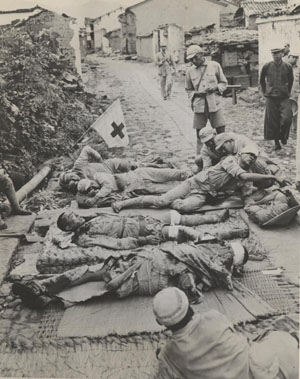 __
__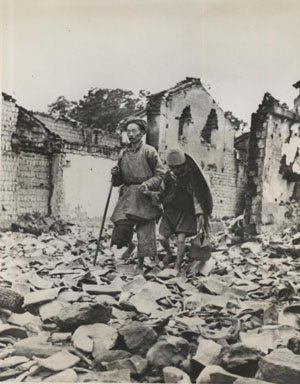 __
__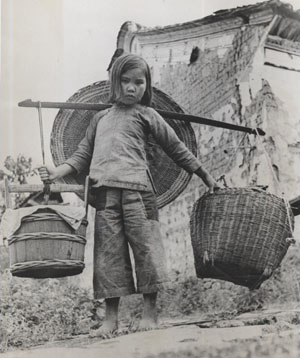
After our Tengchong visit, with heavy hearts, we take a break at a remote and beautiful hot springs where we toast our feet and eat wild mushrooms cooked in the sulfer brew.
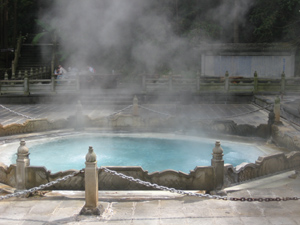 __
__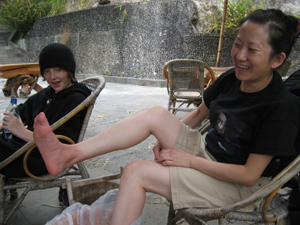
We end our day with a wonderful dinner hosted by Zhang Jian, the mayor of Tenchong. There is quite a surprise at the dinner -- Yang Fuquan is there. We met him in Schenectady at Union College where he gave a lecture on Mosuo culture. He is Vice-President of the Yunnan Academy of Social Sciences and President of the Association for Naxi Studies. During dinner, in view of the Mosuo custom of "visiting marriages," he is interested in Devin discourse on all of the girlfriends he has had. At some point Professor Yang asks Devin what love means. Devin answers, "I don't really know; I'm just a kid!" To that they toast.
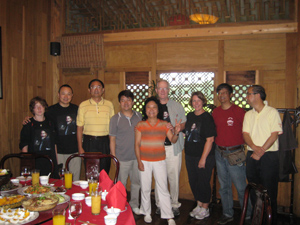 __
__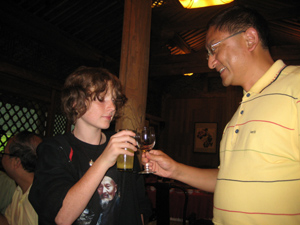
Today we drive from Tengchong to Baoshan. Now we are on the route of the 172nd Hospital convoy headed toward Kunming. Driving through this same country, sixty-three ago, Dr. Millett wrote: "Today we have come into the foothills of the Himalayas and they are the most magnificent sight that I have ever seen. We wound up and up, hairpin curves by the hundreds. Drove in low or 2nd gear most all day, then wound down into the Salween River gorge, which is really a sight. This country is more beautiful than any scenery in the States and one thing you can be sure of is that never will more than a few hundred Americans ever see this country. There is a huge suspension bridge across the Salween. We crossed this and then climbed to the top of the next slope and camped for the night."
Photograph below (left) from Douglas Davis, Sargent with the 172nd Hospital convoy showing the Salween River bridge crossing. Photograph (right) by Kim Millett showing the Salween Bridge in 2008.
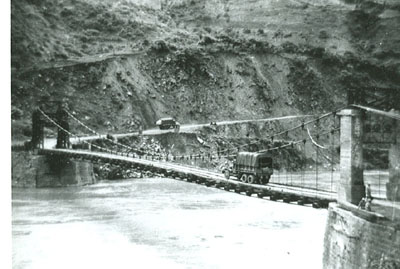 __
__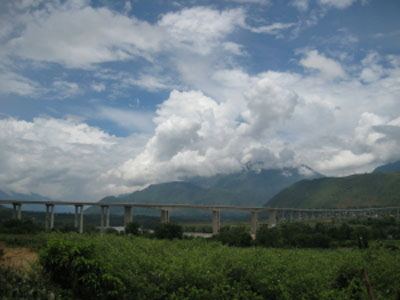
We do not camp at the end of the day. We arrive at the Fortune
Chamber Hotel in Baoshan and have a drink at the the Stillwell Road Bar. The
hotel and bar are owned by by Yang Jian and includes a gallery of WWII photographs.
Yang Jian, his wife, and daughter Mao Chum ("Lisa") host our evening
dinner. Lisa is studying finance at Yunnan University and is home for the semester
break.
After dinner we enjoy a walk around the town square which is bordered by Karaoke
Bars, Tea Houses and shops. Back at the Stilwell Bar Devin buys Li Jia a drink
of Johnnie Walker Red Label!
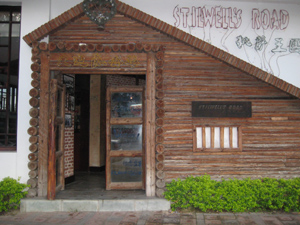 __
__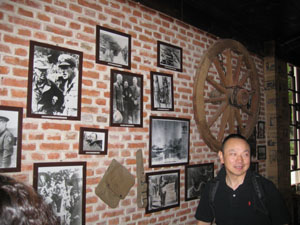 __
__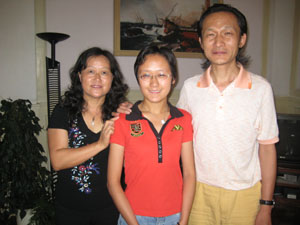
In the morning we enjoy a vist to the Yang home for tea, and
we tour Jian's amazing orchid garden on the top floor. He spends three hours
a day with his orchids and has sold a few for thousands of dollars! Li Jia is
inspired by the orchids, and after having thought for a few days about a Chinese
name for Kim, she names her Hui Lan which means "orchid of high moral character".
After we visit the Yang's we are on our way to Dali. However, we drop Fei Bao off at the Baoshan airport so that he can go back to Kunming and attend to business. He'll fly to join us again on this adventure in a few days in Lijiang! So Fei Bao has left us but Li Jia's dear sister Amy has joined us. She got off the Kunming plane that Fei Bao got on! Amy is great company, and she will be a great addition to the upcoming road trip into the Himalayas because, in a former life, she was a race car driver! That's Amy below enjoying a "pit-stop"!

Amy and Li Jia share the driving as we travel through twelve more tunnels, through steep mountain gorges along side the Mekong River with lots of mountainside agriculture - corn, rice, tobacco, bananas and vegetables. On this part of his trip, Dr. Millett wrote: "The country we are now in is more beautiful mile by mile. Wonderful mountains on all sides with terraced valleys below and very pretty mountain streams. In this part of China the people are extremely poor -- exist and that is all. I would estimate that 90% of adults and 25 to 50% of children have goiters. I have seen thousands and thousands of goiters just driving along the road. Many goiters are as large as 3 or 4 grapefruit. Along with these are hundreds of typical cretins (thyroid dwarfs). The older women in this part all have bound feet but the practice has been discontinued. The way it was originally done was when the child was 2 years old the bones of the feet were broken and then bound and kept bound throughout life. They walk exactly as though walking on stumps and that is what it amounts to. Seeing this part of the counry as in India and everywhere else makes one feel among the chosen few to be an American." Three of Dr. Millett's 1945 photographs are below. We have no images better than these!
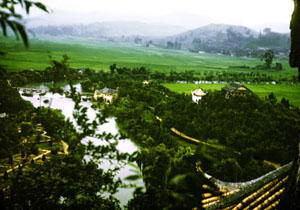 __
__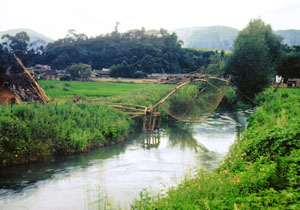 __
__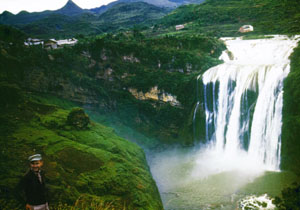
We arrive at Dali, a boom town, and tour through the "old city," but
Li Jia says we're going to spend the night at the home of a friend of her's
-- but it's a surprise. We drive for another hour around Lake Erhai. We speculate
-- Gregg thinks it'll be an American style condo; Devin says an American style
home; Kim suggests that it will be unimaginable. We drive through Shuanlang,
an old Bai village, park the car and climb aboard a small boat -- it's starting
to feel as though Kim is right.
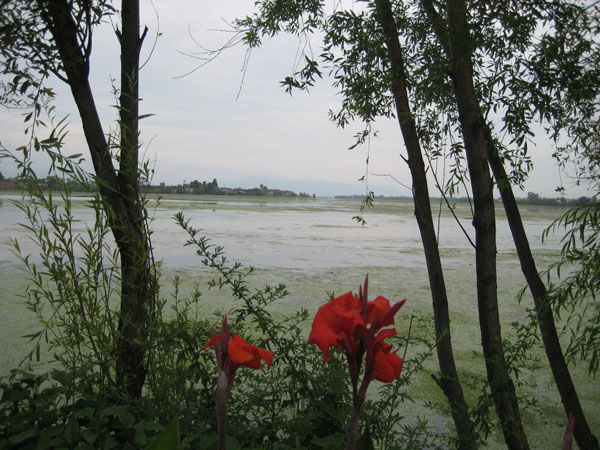
After about five minutes we approach the home of Li Jia's friend. Kim is right!

We are met at the home dock by our hostess (Li Jia's friend), Xiao Pei and shown to our rooms. As pictured below we have bed, bath and way beyond!
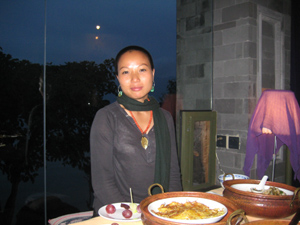 __
__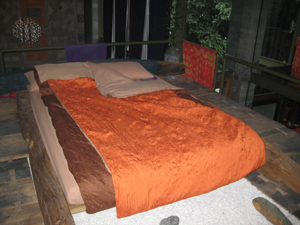 __
__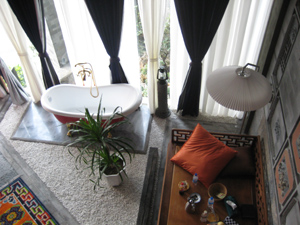
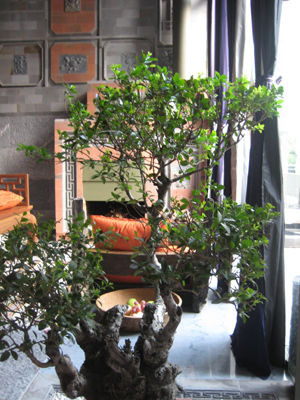 __
__ __
__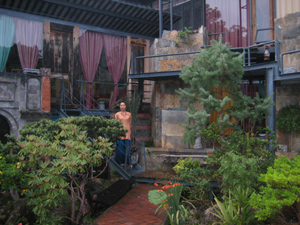
This residence and partial guest house is known as Qing Lu. It was designed by Xiao Pei and her husband Zhao Qing (a famous artist and now home and building designer). Zhao Qing is in Beijing working and Xiao Pei is running the guest house and home schooling their young son, Fuer. After dinner with Mrs. Pei, we spend the evening on a high balcony overlooking the lake, sipping wine and practicing a bit of yoga.
During our three day stay of absolute R and R, we explore Qing Lu. The home is built among giant volcanic boulders with seemingly endless inside-outside spaces. It is on a penninsula, which through narrow streets and a guarded gate, connects with the village of Shuanlan. In Shuanlan, along the lake's shoreline, the developer Mr. Lee is building a shopping and tourist facility which includes a Fei Bao Bar! In Shuanlan we join a group known as "the old poets society." We enjoy watching them share their latest works and answering their cell phones!
With this mystical, luxurious rest on Lake Erhai at the home of Xiao Pei and Zhao Qing, we end our Burma Road adventure because in the morning we'll head north to Lijiang and Lugu Lake.
Intriguing that Dr. Millett also experienced some luxury on his Burma Road trip. On the day before he led his convoy into Kunming he wrote the following: "After driving all day we stopped last night just about four miles short of our destination and are now at the outskirts of the city awaiting our reception committee (the M.P. escort). The country here is really beautiful. It is similar in most respects to the country around Denver. It would be a wonderful place to be stationed.
We had the most unbelievable experience last night. There was a small camp near where we stopped and we asked some boys if there was any place to take a bath. They directed us to a hotel about 10 miles away and said it was very good. We expected the usual mud brick flop house with public shower. When we arrived we found a very small city, modern in every respect with paved streets, running water, sewers and electricity. Every building was pink stucco with tile roofs. One beautiful house was owned by a Chinese general. The town is located on the site of a warm natural spring. The hotel is pink stucco, 4 stories high, built around a beautiful patio. We asked for a bath and they took us each to a room about 12 by 25 feet, all tile with little steps that led down to a pool filled with clean, warm water. Also in the room was a bowl and a shower with shower heads pointed from all sides. We were a pretty dirty lot so it really felt like we had arrived in Shangri La. We spent about an hour lounging in the pool. After our bath we went into the bar room, which was strictly up-town. Had a Tom Collins then had dinner. What a dinner - liver soup and scrambled eggs with ham. Then the main course - fried chicken, french fries and green peas! Dessert was cake with nuts and fruit with delicious dressing over it and plenty of real good coffee. After dinner we walked around a while and went back to camp.
I'm still pinching myself. Got up this morning and went back to the hotel for breakfast. Had ham, 3 fried eggs, good toast, apple butter and coffee. Being stationed real near this place would be wonderful. While there last night we looked at their rooms. They are suites - living room and bedroom, beautifully furnished with modern furniture and inner spring mattresses. This hotel was built only two years ago. It is actually a resort and most of the people staying there are very wealthy Chinese. We saw many families there, apparently who have evacuated some other city and are staying there for the duration."
Just a note: Kim and Gregg are pinching each other every day!
Below: First US Army convoy enters Kunming -- February 4, 1945 (left); Dr. Millett's hospital convoy enters Kunming -- April 10, 1945 (center); Gregg, Kim and Devin arrive back in Kunming -- August 12, 2008 (right).
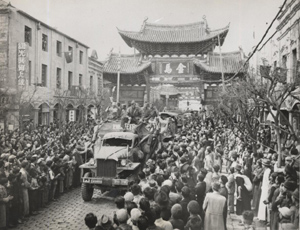 __
__ __
__